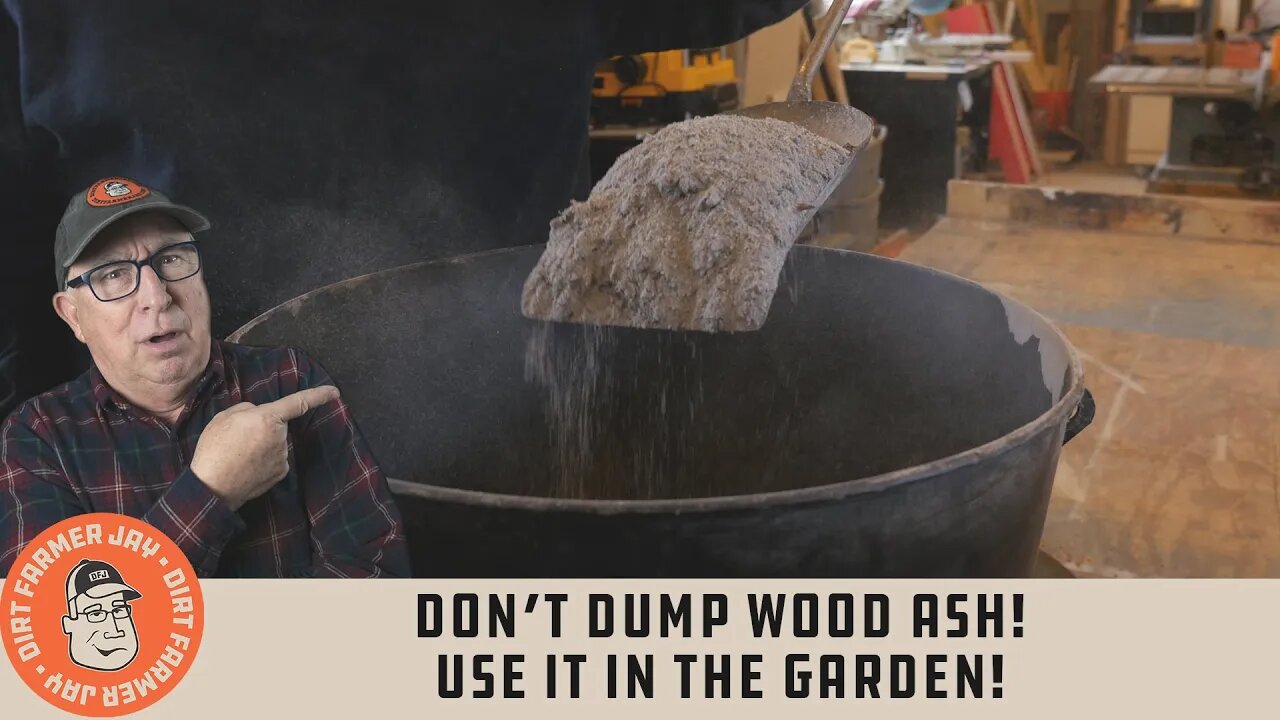Premium Only Content

Don’t Dump Wood Ash! Use It in the Garden!
If you heat your home or shop with a wood stove, then you’re going to create a lot of wood ash. The good news is that it can be used in your garden - with a few caveats.
#woodash #potash #potassium
Buy your DFJ T-Shirt, Cap, or Coffee Mug at https://www.dirtfarmerjay.com/shop
Wood ash contains a lot of potassium and calcium as well as smaller amounts of magnesium and phosphorus, and micronutrients such as copper and zinc. These are all desirable in the garden, whether a food plot or an ornamental space.
If you’ve got a fireplace or woodburning stove, then you’ve likely got ash to dispose of. Appropriately used, ash can be used as a resource, instead of being something to deal with as a waste product!
Keep a couple of things in mind. Products such as particle board, oriented strand board (OSB), medium-density fiberboard (MDF), Masonite® type products, peg board, treated lumber, or railroad ties should not have been used for fuel in the ash you’re going to use in the garden. There are too many chemicals, glues, and binders to deal with to yield ash that doesn’t have toxins. The same goes for plastics, cardboard, melamine, or painted wood.
Next, keep in mind that ash is alkaline, meaning its pH is higher than 7. Wood ash was the historical way of producing potash - which is also known as lye. To make lye, our ancestors soaked ash from wood or plant material in water and collected the resulting water-soluble alkaline solution.
This solution is called potassium hydroxide, caustic potash, or lye. Lye is used in manufacturing a multitude of products. A few of those products are soap, paints, cleaners, drain cleaners, biodiesel, textiles, and fuel cells.
When using wood ash in your garden or yardscape, remember that if you have alkaline soil (pH greater than 7), then you need to use the ash very lightly so as not to increase the pH further. If the soil in your area is acidic (pH lower than 7), then wood ash can be used in greater quantities and will actually help bring the soil closer to a neutral pH of 7.
No matter where you are, don’t put piles or clumps of ash in any one area. The proper application method is to dust or spread the material on a calm day (we recommend you wear a dust mask just to be safe!), on moist ground, or water it in immediately after if the soil is dry.
Wood ash is extremely water soluble and will “melt” into the soil quickly when water is applied. This gets the potassium into the root zone of plantings and delivers its full benefits right away.
You can use the ash in your compost pile as well if you use the same dusting process and don’t add more than 5 to 10% total volume to the pile. The pile will get a nice potassium boost without changing up pH and disrupting the composting process.
Lastly, no matter what area of the country you are in, rhubarb plants tend to acidify the soil around them because the leaves contain oxalic acid. At the season’s end, the leaves decompose around the base of the plant and over time can make the soil acidic. This tends to affect the color of the rhubarb stalks. Acidic soil tends to grow green stalks with a minimum of red.
This is a great opportunity to use what is typically thought of as a waste product as a growing and soil-conditioning aid. That’s a win-win!
JUST DO IT YOURSELF!
Buy your DFJ T-Shirt, Cap, or Coffee Mug at https://www.dirtfarmerjay.com/shop
Follow us on Social Media to know when we’re building projects or releasing new episodes!
Instagram: https://www.instagram.com/dirtfarmerj
Facebook: https://www.facebook.com/dirtfarmerjay
-
 2:08:05
2:08:05
Badlands Media
19 hours agoDevolution Power Hour Ep. 349: Trump’s Geopolitical Gambits, Sports Psyops, and the Regime’s Unraveling
67.2K29 -
 1:08:36
1:08:36
Man in America
11 hours agoUS, China, Israel & the Battle for the New World Order w/ Boone Cutler
60K42 -
 2:37:49
2:37:49
The Connect: With Johnny Mitchell
1 day ago $6.16 earnedBlackwater Mercenary EXPOSES Private Military War Secrets From The Middle East, Fueling Terrorism
27.7K17 -
 2:54:21
2:54:21
Total Horse Channel
2 days ago2025 Scottsdale Arabian Horse Show | Saturday Evening Session
59.8K5 -
 22:39
22:39
The Mel K Show
8 hours agoMel K & Representative Brandon Gill | Our Constitutional Republic is Being Restored | 4-26-25
48.6K24 -
 4:17:17
4:17:17
VapinGamers
7 hours ago $3.47 earned📣 Fortnite Family Night! - Games and Dubs with BrianZGame - !rumbot
34.4K2 -
 4:27:48
4:27:48
ThePope_Live
6 hours agoLIVE - First time playing The Finals in over a YEAR! Still good? with @Arrowthorn
26.9K1 -
 3:06:26
3:06:26
TruthStream with Joe and Scott
11 hours agoRoundtable with Patriot Underground and News Treason Live 4/26 5pm pacific 8pm Eastern
45.2K33 -
 8:52
8:52
Tundra Tactical
9 hours ago $9.58 earnedSCOTUS Denies Appeal, Minnesota Courts Deal 2a Win!
47.6K11 -
 10:36:01
10:36:01
a12cat34dog
11 hours agoONE WITH THE DARK & SHADOWS :: The Elder Scrolls IV: Oblivion Remastered :: FIRST-TIME PLAYING {18+}
65.2K5